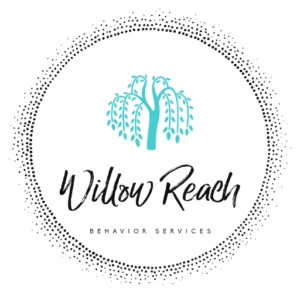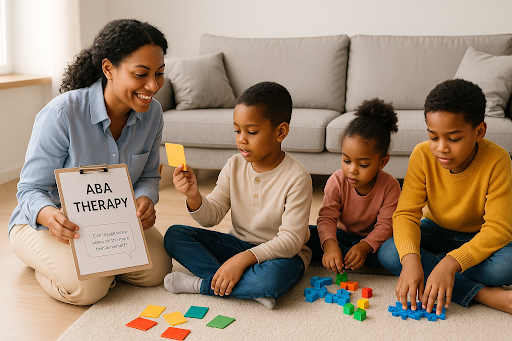You are doing all you can to provide the best support and care for your child.
Yes, it’s okay to feel overwhelmed at times, and it’s okay to not have everything figured out. This is especially true when it comes to the type of ABA therapy you need to provide your child with.
Sure, you must have heard some people say, “one-on-one worked the best for my son,” and then hear someone else say, “group therapy is the more effective one.”
And those differentiating opinions leave you confused as to what direction you need to go in.
But here’s the thing: it is not about which approach is better. It is about what works for your child, your family, and what you hope to achieve.
In this blog, we will go over the difference between group and one-on-one ABA in center based settings so you feel informed, empowered, and most of all supported in your decision.
Why the ABA Setting Matters
In autism behavior therapy, we see that structure is very key. Some kids do better with intensive focus, while others learn best in a social setting. In other words, you should choose between group ABA therapy and one-on-one ABA therapy based on what works best for your child.
Imagine having a private teacher when it comes to ABA for a single child at a time. The therapist’s full attention is on your child, which is used to customize lessons. Also, this is very helpful for kids who are just starting with ABA therapy or require extra support. The pace is slow, but we have time to pause, go back, and make changes as needed.
Now, when it comes to a group setting, children practice sharing, taking turns, and learning from each other. Additionally, this approach is effective for children who are at a suitable social level and will benefit from interacting with their peers.
Each ABA therapy approach is for a different need. We need to find a safe, accepting, and growth-promoting environment for your child.
Related: Center-Based vs. Home-Based ABA Therapy: Which One is Right for Your Child?
Exploring the Differences: Which ABA Setting Supports Your Child Best?
Once you grasp the structure of ABA sessions, it is time to determine which environment best fits your child’s learning style and personality. While we see value in all approaches, what you choose may depend on your child’s emotional, social, and behavioral state at the present time.
Let us look at the difference between these two types of ABA therapy in center based settings.
Group vs One-on-One ABA Sessions in Centers: A Side-by-Side Comparison
| Feature | One-on-One ABA | Group ABA Therapy |
| Therapist-to-Child Ratio | 1:1 | 1:3 to 1:6 (varies by center and need) |
| Focus Areas | Highly individualized | Social skills, generalization |
| Setting | Private, distraction-free | Structured with peer interaction |
| Ideal For | Beginners, focused intervention | Social development, peer learning |
| Progress Tracking | Personalized and data-driven | Group-based goals + individual metrics |
| Flexibility | Highly adaptable to the child’s needs | Moderately structured |
Benefits of Individual ABA Therapy
In individual ABA sessions, we pay full attention. The therapist tailors each moment to your child’s pace and style. These sessions are especially powerful for:
- New learners or those who require extra support in regulating behavior.
- Children who are at the early stages of learning to communicate and developing self-help skills.
- Families that are looking for individualized ABA therapy with regular progress reports and plan updates.
Individual ABA therapy has shown great results, including reduced interruptions, close observation, and the flexibility to try multiple approaches simultaneously. Also, many kids start in this setting before weaning into group-based settings.
Group ABA Therapy Advantages
When a child shows social readiness, group ABA therapy provides great benefits. Peer-based sessions help the children put into practice what they have learnt in a more dynamic, everyday setting. They work on:
- Cooperation and teamwork.
- Perceptual learning (see what others do and imitate).
- Real-life skills like waiting, taking turns, and expressing needs with peers.
Group settings may be a better fit and more social for some kids, including those who enjoy interactions or are in the process of applying what they have learnt.
Why Therapists Recommend One Over the Other
Therapists will start with one-on-one ABA if the child requires it for issues like safety, communication or behavior, which may be at risk. As the child grows in confidence and skill, which is achieved through this initial stage of therapy, the focus may shift to group sessions, which also serve to increase social interaction.
Professionals encourage this normal progression. Many applied behavior analysis plans are designed to grow with the child. Think of it as a child first learning to ride a bike with training wheels and then putting on a helmet and riding among friends in the park. The setting changes as the child does.
How to Choose What’s Best for Your Child
There is no perfect formula, and most importantly, there is no right or wrong choice, just different options which will vary based on your child’s needs and stage in their journey.

Here are some issues to consider:
- Age and developmental stage: Young children or those just starting therapy tend to benefit significantly from one-on-one autism support, which helps build trust and foundational skills.
- Behavioral needs: If your child requires more guidance for managing behaviors, a one-on-one setting can provide the right level of structure and attention.
- Communication skills: Nonverbal and limited verbal children may do well with individual attention; in contrast, those who are verbal and social may thrive in a group setting.
- Sensory profile: Some children do better in quieter, low-stimulation environments. Others may thrive in more dynamic social settings.
- Therapy goals: Your aims, which may be with respect to emotional regulation, social interaction, or academic preparedness, will form the structure of the right ABA session.
Related: When Is the Right Time to Transition from Home-Based to Center-Based ABA?
Willow Reach ABA: Thoughtful, Personalized Support for Every Child
At Willow Reach ABA, we provide a therapy experience that is not limited to the session but is a community journey of compassion, respect, and understanding. Here’s how we support families:
- Center-Based and In-Home Therapy Options: Whether in a central setting or in-home ABA therapy services, we tailor our ABA plans to your child’s unique strengths, needs, and pace.
- Personalized ABA Therapy Plans: Each of our care plans is tailored to the individual needs of the child, which allows for that growth to happen in a natural, almost easy way. Also, we have a very personal approach to ABA therapy, which grows along with your child as they progress.
- A Supportive, Inclusive Environment: From the clinic to your home, we are dedicated to creating a welcoming and inclusive environment for your child, which is free of stress.
- Expert-Led and Goal-Oriented: Led by professional staff, we present a structured ABA session which has defined goals, shows progress, which is measured and is a continuous collaboration with the carers.
- Rooted in Compassion and Clarity: Willow Reach ABA is dedicated to making autism behavior therapy accessible, family-oriented, and meaningful at every turn.

At Willow Reach ABA, your child will experience an individualized and best-fit approach.
Conclusion: It’s Okay To Be Confused
In whatever setting you begin with your child, be it one-on-one applied behavior analysis or in a group ABA therapy environment, what matters most is the way that they are supported and seen for who they are as individuals. Growth may look different for each child, but with a proper plan and dedicated team, progress is very possible.
Choosing the right ABA therapy can be daunting, but you don’t have to know everything right away. Trust your instincts. Ask questions. Have open discussions with your BCBA or care team. What you, as a parent or caregiver, see is of equal importance to professional input.
Autism behavior therapy is not for turning your child into what you think they should be; it is about giving them what they need to thrive in the world, to put into words what they are feeling, and to do what makes them unique.
There is not a single path for all. Each child has his or her own journey, and with care, understanding, and the right structure, we may see that play out as something very beautiful.
Frequently Asked Questions
- What if my child switches from one-on-one ABA to group therapy – will their progress slow down?
Not always. What we see is that transitioning into an ABA group setting is a mark of progress. It is the sign that your child is ready to work on skills like communication, turn-taking or emotional regulation in a more social setting. While progress may look different for each child, therapists adjust goals and methods to support that growth in the new setting.
- Are ABA therapy goals different in group vs. individual sessions?
Yes, they are specifically designed based on the setting. In one-on-one ABA, we may see that goals include issues of everyday routines, reduction in out-of-line behavior, and enhancement of language. Goals in groups typically involve social interaction, teamwork, and applying individual learning to real-world situations.
- Can my child receive both one-on-one and group ABA therapy at the same time?
Absolutely. Many therapy plans combine both formats to give your child the best of what each has to offer. This hybrid model does a great job of, at the same time, setting individual goals and promoting social interaction, which gives you that full picture of a well-balanced ABA therapy session.
- How does Willow Reach ABA support parents throughout the ABA process?
Willow Reach ABA is big on family support. We have a team that does regular check-ins and reports out on progress, and we also work as a team with parents and carers. We aim to make the process easy to understand, inclusive, and stress-free.
- What makes Willow Reach ABA different from other ABA providers?
Our hallmark is an intense focus on compassion and personalization. In all we do at Willow Reach ABA, from our structured center-based care to our more casual in-home sessions, we put into practice the value of building meaningful relationships, and we deliver a support system that is respectful and that we tailor to each family’s way of life.
If you want to stay in touch or see what other families are going through on our journey, come follow us at Willow Reach ABA on Instagram and Facebook. We are always here to share and to learn from each other.

